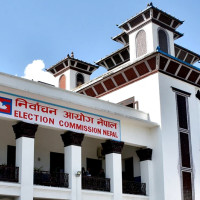- Monday, 8 December 2025
Film industry on recovery course
Kathmandu, July 3: The Nepali film industry, almost six decades after the first Nepali film Ama was produced in Nepali soil, was still struggling for its survival and success when the COVID-19 pandemic dealt it a deadly blow in March 2020.
The COVID-19 pandemic and a lengthy lockdown imposed since 2020 had put the entire entertainment industry on deathbed bringing all activities of the industry to a complete halt for about one and a half years and rendering hundreds of people working in the film sector jobless.
It is only since October last year, the film industry, especially the cinema theatres, started getting a new lease of life when a few Bollywood and Hollywood films could pull the people to the halls which had remained deserted for months. However, local films had to wait for the release of Ma Yasto Geet Gaauchhu on Februray 25 to see light at the end of the tunnel. The film directed by Sudarshan Thapa at least instilled hope among the disappointed
Nepali filmmakers that the industry wouldn't die.
With a massive success of Kabaddi-4 (released on May 27) and E Mero Hajur (released on April 14) in the box-office, the film industry has witnessed a steady ascent , sending a clear message to all the filmmakers that only good Nepali films could win the hearts of Nepali audience. The envying record earning of Rs. 250 million made by Kabaddi-4 – Chhakka Panja sequel had grossed Rs. 200 million in 2018 - has proved that a good film always thrives . Otherwise, the local producers and filmmakers as usual will be blaming the foreign films for the poor show of their low-quality films in the local theatres. Of course, making formula films based on the same old stories of conflict between the well-off and poor families over the affairs of their offspring had been in practice for over five decades.
But with the entry of a few learned filmmakers in the profession in recent years the trend of making formula films has gradually been altered. The Nepali films which succeeded in the box office in the post-COVID-19 situation were not formula films. They were different from formula films, so they could earn better.
Ram Babu Gurung’s Kabaddi 4: The Final Match made a history by earning around Rs. 250 million, if we are to believe the claim made by its distributor Manoj Rathi.
The film is still being screened in the local halls, which means its earning will be further higher. Rathi said that the film did a good business as the viewers watched it repeatedly.
A Mero Hajur-4 and Ma Yesto Geet Gaauchhu-2 were other films to become hits in the post-COVID-19 period.
According to distributor Govinda Shahi, A Mero Hajur-4 directed by Jharna Thapa fetched Rs. 50 million.
Ma Yesto Geet Gaauchhu-2 has also grossed over Rs. 50 million, according to Karan Shrestha, a distributor. Likewise, Dipendra K Khanal’s Chiso Manchhe which is being screened in the halls has so far earned more than Rs. 20 million across the country, said Karan Shrestha.
However, there is no similarity between the box office figures and the claims made by filmmakers and distributors regarding their collections.
According to the government box office records, Kabaddi-4: The Final Match grossed Rs. 170 million, A Mero Hajur-4 over Rs. 25 million, Ma Yesto Geet Gaauchhu-2 over Rs. 15 million, Kathaputali over Rs. 10 million, Chiso Manche over Rs. 10 million, Lappan Chappan 2 over Rs. 1 million and Lakka Jawan more than Rs. 400,000.
Stating that some films have made unprecedented success in the post-Covid period, Shrestha said that if the production, distribution and exhibition of the films is managed well, the market for Nepali films will reach Rs. 500 million.
However, film experts said that the film industry has not rekindled yet.
Senior filmmaker Tulsi Ghimire said that Nepali films have risen a bit but the industry has not been fully restored.
“Filmmakers are afraid of making off-beat films because the government here does not support the film industry like in other countries,” Ghimire, who offered most of the hit films to the industry in the past, said. “But looking at the current scenario, I am confident that the audience will always visit the halls to watch a good movie.”
Film expert Prakash Sayami also said that the Nepali cinema has not yet recovered from the damage done by COVID-19. “This industry will revive only when the filmmakers repeatedly produce better films,” he said.
Ironically, established filmmakers in Nepal are not daring to make new films.
Currently, a few films are doing well at the box office but this is not a good sign for the overall development of the film industry, he added.
He said that the Nepali film industry is being run on the basis of nepotism or groupism, therefore, only a few films were able to make a profit, said Sayami.
According to him, quality of Nepali films has deteriorated in lack of research, thought-provoking stories and lack of novelty in acting. He suggested making films of different genres rather than repeating the same story over and over again.
As long as the same genre’s film are made and the same type of acting continues, the film industry will not make any development, neither will a good actor be born, he added. He also blamed the filmmakers for ruining the mindset of the audience. “By making the same ordinary film, the filmmakers have created a mentality in the audience that they should watch foreign films to experience the good quality,” he said.
Senior filmmaker and artiste Nir Shah said that the trend of cinema has changed in every seven to 10 years and the success of a film depends on various factors.
According to Aakash Adhikari, president of the Film Producers Association, about Rs. 2.5 billion is invested in the Nepali film sector every year.
There is also a talk of tax exemption by the government to raise Nepali films.
But Raju Pyakurel, director of Internal Revenue Department, in a discussion programme held recently on the tax provision for Nepali film industry, said that tax should be paid on profit.
He said that in the current fiscal year there is a provision that if a separate cabin is built inside a cinema hall, 20 per cent movie fee is charged, but in the case of Nepali films, there is exemption of this charge.
All taxes are collected by the Internal Revenue Department and the Customs Office but the film development fee is collected by the Film Development Board, he added.
The tax system is divided into three categories -- small business, medium business and large business. Small businesses with a transaction of Rs. 3 million and making an income of Rs. 300,000 annually are given 75 per cent tax exemption.
Those businesses earning Rs. 3 million to Rs. 10 million enjoy 50 per cent tax exemption but the businesses earning more than Rs. 10 million do not get any tax exemption.
However, the government exempts tax in all the three sectors including film production, distribution and exhibition.
These three sectors of the film have to pay only 50 per cent trade tax if their trade is more than 10 million rupees.
As more films are waiting for their release, the film industry may witness a revival in the next fiscal. According to the data of Film Development Board, 39 films are recommended for the Film Censor Board in the fiscal year 2078/79 BS.

















